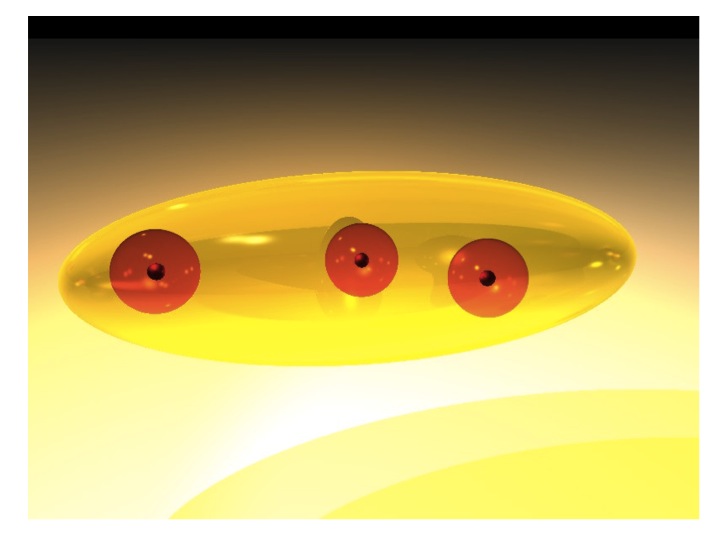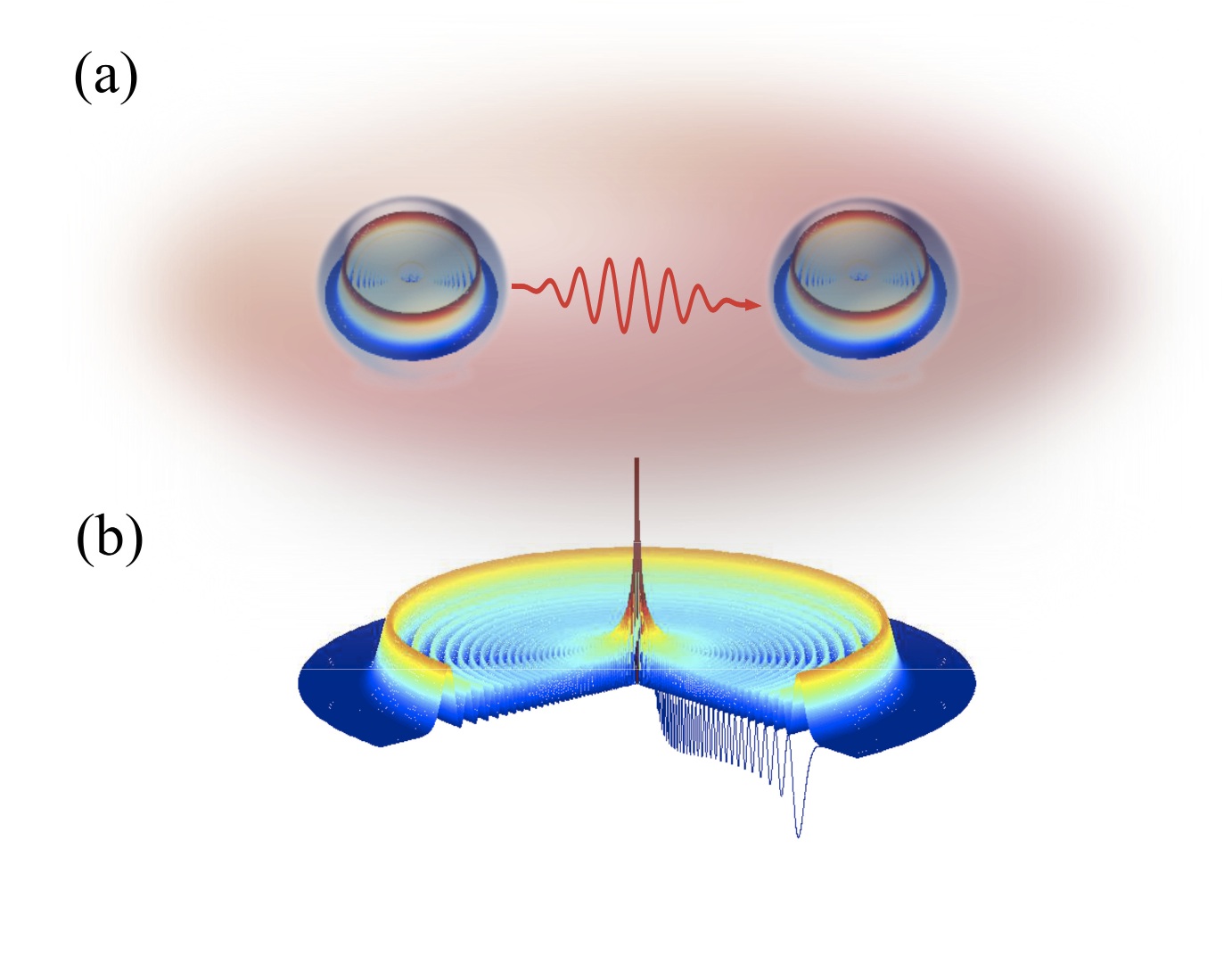Ultracold atomic samples have been used to reach the quantum
degenerate regime in bosonic and fermionic systems, leading
to investigations of Bose-Einstein condensation (BEC) and the
Bardeen-Cooper-Schrieffer (BCS) mechanism in which pairs of
fermions are formed (originally theorized to explain superconductivity).
In our group, we study different aspects of BEC physics,
such as how "impurity atoms" (i.e. an atom distinguishable from
the atoms in the BEC) interact with the BEC. For example, cooling
an impurity atom using a BEC is limited by the superfluidity
properties of the BEC: if the velocity of the impurity is smaller
than the speed of sound in the BEC, conservation of energy and
momentum prevents scattering and thus further cooling of the
impurity. This prediction was first observed by the MIT group in
their Na BEC experiment. We also work on sympathetic cooling
strategies that can successfully mitigate fermion-hole heating
in a dilute atomic Fermi-Bose mixture to access the temperature
regime in which fermions behave as a Fermi liquid.
The behavior of a BEC is dictated by the scattering length, a
parameter that describes the strength of the short-range interaction
between atoms. Although it is a "length", it can be positive or
negative, corresponding to repulsive or attractive interactions,
respectively. A positive scattering length leads to a stable BEC,
while a negative value allows for only small condensates, larger
ones being unstable. We studied this behavior using a simplified
description of the dynamics based on self-similarity, an assumption
in which the time-evolving BEC preserves its shape (i.e. the density
profile remains similar to the initial profile). We also applied
this simple description to show how the expansion of phase-coherent
BECs from optical lattice sites can be used for the purpose of imaging.
 Although the first atomic BECs were obtained with Rb and Na
samples, the "race" to condensation started with hydrogen,
which was finally bose-condensed in 1998 by Kleppner's group
at MIT. One of the challenges with H is the small scattering
length and elastic cross section which prevent fast thermalization
and efficient evaporative cooling essential to reach the conditions
for bose-condensation. We explored the dynamics for H assuming
that the sample could not thermalize fast enough, leading to a
first-order phase transition and the formation of local BEC
droplets. The model we developed reproduces the experimental observations.
Although the first atomic BECs were obtained with Rb and Na
samples, the "race" to condensation started with hydrogen,
which was finally bose-condensed in 1998 by Kleppner's group
at MIT. One of the challenges with H is the small scattering
length and elastic cross section which prevent fast thermalization
and efficient evaporative cooling essential to reach the conditions
for bose-condensation. We explored the dynamics for H assuming
that the sample could not thermalize fast enough, leading to a
first-order phase transition and the formation of local BEC
droplets. The model we developed reproduces the experimental observations.
An important tool in degenerate gas studies is provided by Feshbach resonances,
which allow one to control the interaction between the various
particles in the sample (see Ultracold Collisions). When interactions
between atoms in a BEC are tuned to a Feshbach resonance, we
predicted that a second condensate component of molecules
would appear; both atomic and molecular condensates coherently
exchange pairs of atoms (see figure beside). This prediction was
observed experimentally. In addition, depending on the "separation"
(or detuning) from the Feshbach resonance, we found that the sample
would have a rarefied liquid-like ground state, i.e. if the
trapping potential is removed, the sample would remain with a
finite self-determined density.
 Another important tool to study and probe degenerate quantum
gases is light. We study photoassociation of atoms into molecules
in BECs in which coherence plays an important role. One can
also drive superfluidity in a two-component Fermi degenerate
gas using photoassociation, by adjusting the atom-atom
interaction and controlling the critical temperature of
the BCS transition to the superfluid state. We also
investigate how two-photon spectroscopy could be used to
determine the temperature of a degenerate Fermi gas
(otherwise a difficult task), and to probe the BEC-BCS
crossover region in degenerate Fermi gases (a point where
Cooper pairs of fermion form bosons which can then
bose-condense).
Another important tool to study and probe degenerate quantum
gases is light. We study photoassociation of atoms into molecules
in BECs in which coherence plays an important role. One can
also drive superfluidity in a two-component Fermi degenerate
gas using photoassociation, by adjusting the atom-atom
interaction and controlling the critical temperature of
the BCS transition to the superfluid state. We also
investigate how two-photon spectroscopy could be used to
determine the temperature of a degenerate Fermi gas
(otherwise a difficult task), and to probe the BEC-BCS
crossover region in degenerate Fermi gases (a point where
Cooper pairs of fermion form bosons which can then
bose-condense).
Finally, our group is involved in other less "traditional"
studies of degenerate gases, in which a BEC is used as a
"background" to investigate new phenomena. For example,
we predicted the formation of large mesoscopic metastable
molecular ions when ions are placed into a BEC: the
polarization potentials produced by the ionic impurities
are capable of capturing hundreds of atoms into loosely
bound states (see figure beside, where the orange spheres
surrounding the red ions represent the mesoscopic "bubble"
of atoms captured from the BEC yellow "jelly bean"). These
hollow molecular ions could be formed via phonon emission.
We suggested an optical technique for coherent stimulated
transitions of condensate atoms into a specific bound state
(see
Atom-ion scattering and doped ultracold samples for more details).
 We also explore how Rydberg atoms' interactions are modified
if immersed into a BEC. Basically, the highly excited electron in
the Rydberg atom scatters off the ground state atoms of the BEC,
an interaction that is well approximated by a contact potential.
This creates phonons (excitations of the BEC) that lead to Yukawa
potentials mediating the interaction of electrons. We found two
regimes characterized by the healing length of the BEC.
For small healing length, the electron experiences a self-interaction
that maps its wave function onto the density of the BEC. Under
appropriate conditions, this could lead to the imaging of the Rydberg
electron density. For large healing length, the phonon-exchange between
Rydberg electrons again gives an attractive Yukawa potential between
two Rydberg atoms. Again, under appropriate conditions, this interaction
could bind a pair of Rydberg atoms that would otherwise be repelling
each other. In some ways, the "vacuum" is dressed by the BEC, and the
effective interaction is now affected by phonon-exchange. Because
the Yukawa potential
More details
are given in a recent manuscript (see
arXiv:1410.7853).
We also explore how Rydberg atoms' interactions are modified
if immersed into a BEC. Basically, the highly excited electron in
the Rydberg atom scatters off the ground state atoms of the BEC,
an interaction that is well approximated by a contact potential.
This creates phonons (excitations of the BEC) that lead to Yukawa
potentials mediating the interaction of electrons. We found two
regimes characterized by the healing length of the BEC.
For small healing length, the electron experiences a self-interaction
that maps its wave function onto the density of the BEC. Under
appropriate conditions, this could lead to the imaging of the Rydberg
electron density. For large healing length, the phonon-exchange between
Rydberg electrons again gives an attractive Yukawa potential between
two Rydberg atoms. Again, under appropriate conditions, this interaction
could bind a pair of Rydberg atoms that would otherwise be repelling
each other. In some ways, the "vacuum" is dressed by the BEC, and the
effective interaction is now affected by phonon-exchange. Because
the Yukawa potential
More details
are given in a recent manuscript (see
arXiv:1410.7853).